Related Research Articles

Alfa Romeo Automobiles S.p.A. is an Italian luxury carmaker known for its sports-oriented vehicles, strong auto racing heritage, and iconic design. Headquartered in Turin, Italy, it is a subsidiary of Stellantis Europe and one of 14 brands of multinational automotive company Stellantis.
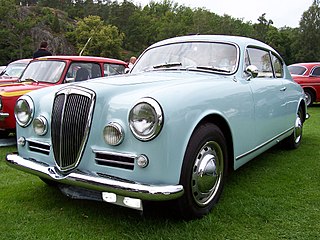
A grand tourer (GT) is a type of car that is designed for high speed and long-distance driving due to a combination of performance and luxury attributes. The most common format is a front-engine, rear-wheel-drive two-door coupé with either a two-seat or a 2+2 arrangement. Grand tourers are most often the coupé derivative of luxury saloons or sedans. Many iconic car models, such as the Ferrari 250 GT, Jaguar E-Type, and Aston Martin DB5, are considered classic examples of gran turismo cars.
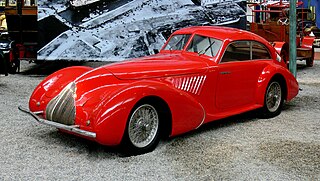
The Alfa Romeo 8C was a range of Alfa Romeo road, race and sports cars of the 1930s.

Alfa Romeo Giulia is the name of three not directly related models by the Italian car manufacturer Alfa Romeo. The first is a line of sporty four-door compact executive cars produced from 1962 to 1978, the second is an updated, mainly up-engined Spider, Sprint and Sprint Speciale Giuliettas, and the third Giulia is a compact executive car unveiled in 2015.

The Alfa Romeo GTA is a coupé automobile manufactured by the Italian manufacturer Alfa Romeo from 1965 to 1971. It was made for racing (Corsa) and road use (Stradale).

The Alfa Romeo Twin Cam engine is an all-alloy inline-four engine series produced by Alfa Romeo from 1954 to 1994. In Italian it is known as the "bialbero" ("twin-shaft"), and has also been nicknamed the "Nord" (North) engine in reference to its being built in Portello, Milan, in the North of Italy and to distinguish it from the Alfa Romeo Boxer engine built in the South (Sud) for the Alfasud.
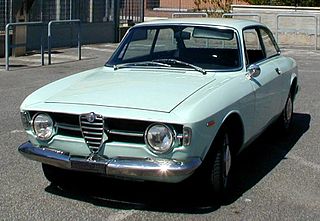
The Alfa Romeo 105 and 115 series coupés are a range of cars made by the Italian manufacturer Alfa Romeo from 1963 until 1977, based on a shortened floorpan from the Giulia saloon. They were the successors to the Giulietta Sprint coupé.

The Alfa Romeo 33 Stradale is a mid-engine sports car built by Italian automobile manufacturer Alfa Romeo. It was the fastest commercially available car for the standing kilometer upon its introduction. 18 examples were produced between 1967 and 1969. "Stradale" is a term often used by Italian car manufacturers to indicate a street-legal version of a racing car; indeed the 33 Stradale was derived from the Tipo 33 sports prototype. Built in an attempt by Alfa Romeo to make some of its racing technology available to the public, it was also the most expensive automobile for sale to the public in 1968 at US$17,000.

The Alfa Romeo Nuvola is a concept car with coupé body first shown by Alfa Romeo at the Mondial de l'Automobile Paris motor show in 1996. Nuvola literally means "cloud" in Italian, but also hints to the legendary Italian racing driver Tazio Nuvolari. The Nuvola has a front-mounted engine and four wheel drive. The prototype is currently on display at the Alfa Romeo Historical Museum in Arese, Italy.

The Alfa Romeo Giulietta is a family of automobiles made by Italian car manufacturer Alfa Romeo from 1954 until 1965 which included a 2+2 coupé, four-door saloon, estate, spider, Sprint, and Sprint Speciale. The 2+2 was Alfa Romeo's first successful foray into the 1.3-litre class. From 1954 to 1965 a total of 177,690 Giuliettas were made, the great majority in saloon (Berlina), Sprint coupé, or Spider body styles, but also as Sprint Speciale and Sprint Zagato coupés, and the rare Promiscua estate.
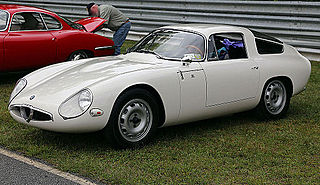
The Alfa Romeo Giulia TZ was a sports car and racing car manufactured by Alfa Romeo from 1963 to 1967. It replaced the Giulietta SZ. In 2011, the name was reduced from Giulia TZ to TZ in the new TZ3 model.
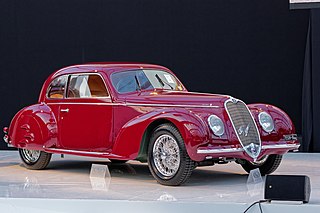
The Alfa Romeo 6C name was used on road, race, and sports cars produced between 1927 and 1954 by Alfa Romeo; the "6C" name refers to the six cylinders of the car's straight-six engine. Bodies for these cars were made by coachbuilders such as James Young, Zagato, Touring Superleggera, Castagna, and Pinin Farina. Beginning in 1933 there was also a 6C version with an Alfa factory body, built in Portello. In the early 1920s Vittorio Jano received a commission to create a lightweight, high performance vehicle to replace the Giuseppe Merosi designed RL and RM models. The car was introduced in April 1925 at the Salone dell' Automobile di Milano as the 6C 1500. It was based on Alfa's P2 Grand Prix car, using a single overhead cam 1,487 cc in-line six-cylinder engine, producing 44 horsepower. In 1928 the 1500 Sport was presented, which was the first Alfa Romeo road car with double overhead camshafts.

The Alfa Romeo Gran Sport Quattroruote is a two-seater roadster made between 1965 and 1967 by Italian car manufacturer Alfa Romeo and the coachbuilder Zagato. The car wears retro bodywork by Zagato, replicating the Alfa Romeo 6C 1750 Gran Sport Spider Zagato of the early 1930s, over then-modern Alfa Romeo Giulia mechanicals. Just 92 were made.

The Lancia LC2 was a series of racing cars built by Italian automobile manufacturer Lancia and powered by engines built by their sister company Ferrari. They were part of Lancia's official factory-backed effort in the World Sportscar Championship from 1983 to 1986, although they continued to be used by privateer teams until 1991. They were also the company's first car meeting the FIA's new Group C regulations for sports prototypes.

Ilario Bandini was an Italian businessman, racing driver, and racing car manufacturer.

The Alfa Romeo Giulia is a compact executive car produced by the Italian manufacturer Alfa Romeo. Known internally as the Type 952, it was unveiled in June 2015, with market launch scheduled for February 2016, and it is the first saloon offered by Alfa Romeo after the production of the 159 ended in 2011. The Giulia is also the first mass-market Alfa Romeo vehicle in over two decades to use a longitudinal rear-wheel drive platform, since the 75 which was discontinued in 1992. The Giulia was second in 2017 European Car of the Year voting and was named Motor Trend Car of the Year for 2018. In 2018, Giulia was awarded the Compasso d'Oro industrial design award.

The Alfa Romeo Giulietta Sprint Speciale and Alfa Romeo Giulia Sprint Speciale, also known as Giulietta SS and Giulia SS, are small sports cars manufactured by Alfa Romeo from 1959 to 1966.
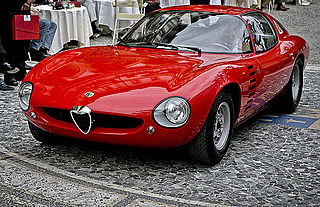
The Alfa Romeo Canguro is a concept car designed by Giorgetto Giugiaro at Bertone. The car is based on the chassis of an Alfa Romeo TZ and was shown at the 1964 Paris Motor Show. The body is made of fiberglass rather than aluminium and it features one of the first glued in windscreens in a car. The name "Canguro" means Kangaroo in Italian.
Neri and Bonacini, also known as Nembo, was a small carrozzeria and mechanic shop based in Modena, Italy, active from the late 1950s to around 1967. Founded and run by Giorgio Neri and Luciano Bonacini, the shop worked on and produced bodies for Ferrari, Lamborghini and Maserati road and race cars, both in an official capacity for those manufacturers and for private owners. Their best known projects are the Ferrari 250 GT-based Nembo spiders and the Lamborghini 400GT Monza. Neri and Bonacini also designed a car under their own name, the Neri and Bonacini Studio GT Due Litri. Two prototypes of this car were made between 1966 and 1968 but it never entered series production. The shop closed around 1967 when Bonacini went to work for De Tomaso and Neri started his own shop, Motors-World-Machines (MWM).

The Quadrifoglio is the brand used by the Italian auto manufacturer Alfa Romeo to indicate a high performance model. The Quadrifoglio is usually placed on the side panels of the car, above or behind the front wheels—on the front wings in the case of modern vehicles. The logo consists of a green four-leaf clover contained in a triangle.
References
- 1 2 3 4 "Se ne sono andati - Parma". repubblica.it (in Italian). La Repubblica. 2 September 2008. Retrieved 2 May 2021.
- 1 2 3 4 5 6 7 8 9 10 11 12 13 14 15 16 Balestra, Nino (2019). "Marche Italiane Scomparse: Aguzzoli "Condor"". EpocAuto (in Italian). No. 7. Faenza, Italy: Edizioni C&C S.r.l. pp. 22–23.
- 1 2 3 4 5 6 7 8 9 Berruti, Valerio; Magistà, Aurelio, eds. (2009). L'Automobile. Marche e modelli dalle origini ad oggi (in Italian). Vol. 1. La Biblioteca di Repubblica-L'Espresso. p. 42.
- 1 2 Cruickshank, Gordon (March 2019). "Swooning sixties". Motor Sport Magazine . pp. 38–39.
- ↑ Racing Sports Cars – A.R. Aguzzoli
- ↑ World Sports Racing Prototypes – World Championship 1965
- ↑ World Sports Racing Prototypes – World Championship 1966
- ↑ Racing Sports Cars – Aguzzoli 1600